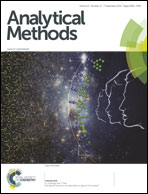A europium-based fluorescence probe for detection of thiols in urine†
Abstract
It is extremely necessary to develop a simple and sensitive analytical method for the detection of biothiols in biological fluids due to their vital biological functions. In this study, a fluorescent europium tetracycline complex (EuTc) was employed as a probe to detect biothiols, which is based on the enhancement and quenching of fluorescence of the EuTc complex by H2O2 and biothiols. After the addition of H2O2, significant enhancement in the fluorescence of EuTc can be observed due to the replacement of coordinated water molecules and the formation of a EuTc–H2O2 complex. In the presence of biothiols, however, the fluorescence of the EuTc complex was quenched due to the formation of disulfide bonds by H2O2. The fluorescence intensity of EuTc decreased linearly with increasing concentrations of biothiols. The detection limits for Cys, GSH and Hcys in aqueous solutions are 100 nM, 200 nM and 400 nM, respectively. The EuTc complex was successfully applied to detect total thiols in urine samples which showed a satisfactory result. Compared with other methods, the proposed method is advantageous because it provides a simple and low-toxicity detection procedure for thiols and possesses the ability to eliminate background fluorescence.


 Please wait while we load your content...
Please wait while we load your content...